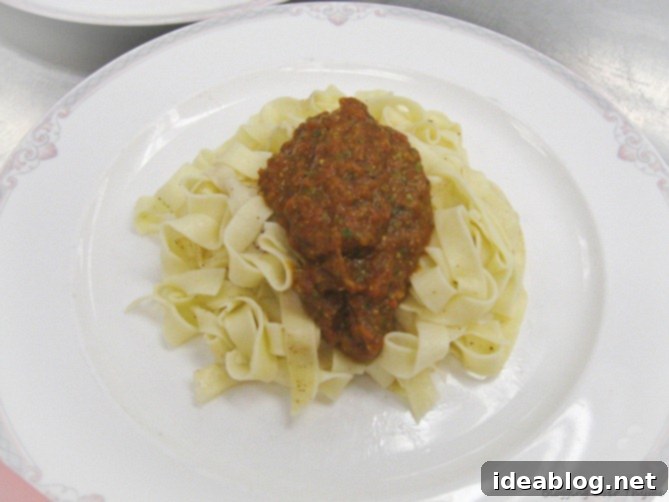Culinary Immersion: Mastering Homemade Pasta, Perfect Omelets, and Exquisite Paris-Brest
Day 13 of my culinary program proved to be an exceptional highlight, marking a significant milestone in my journey. It was a day brimming with foundational techniques and exciting firsts, most notably our deep dive into the art of making fresh, homemade pasta from scratch. As a devoted pasta enthusiast, the prospect of officially mastering this beloved dish in a professional setting filled me with immense anticipation and excitement.
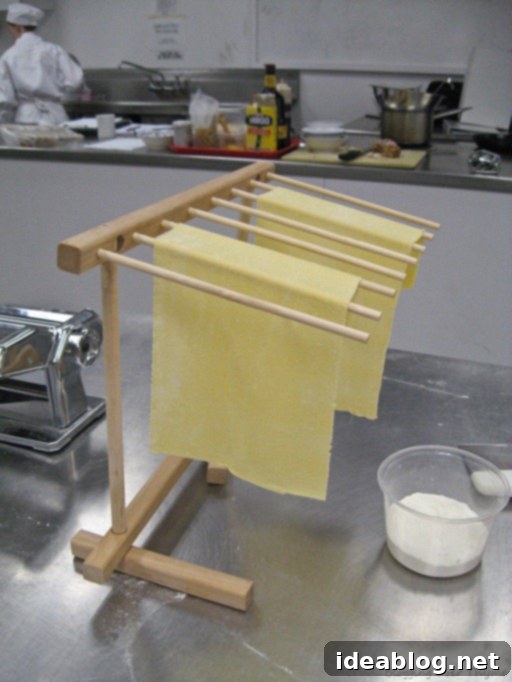
The Art of Hand-Rolled Pasta: A Journey to Perfection
While I’ve experimented with homemade pasta before, even tackling variations like chickpea flour pasta and ravioli, I often felt uncertain about my technique. My previous attempts typically involved a mix of all-purpose and semolina flours. In class, we were introduced to “pasta flour,” a specialized blend of hard wheat (high-gluten) and soft wheat (low-gluten) flours. This combination is crucial: the hard wheat provides the signature chewy texture that is so desirable in fresh pasta, while the soft wheat contributes a delicate tenderness to the finished product, creating a perfectly balanced mouthfeel.
Although future lessons will cover the efficiency of food processors and mechanical rollers for pasta making, Phase I of our program is dedicated to mastering fundamental techniques and building essential skills. Therefore, our first experience with pasta was entirely by hand, relying solely on our work tables and innate culinary touch. This approach ensures a deep understanding of the dough’s texture and behavior, skills that are invaluable regardless of the tools used later.
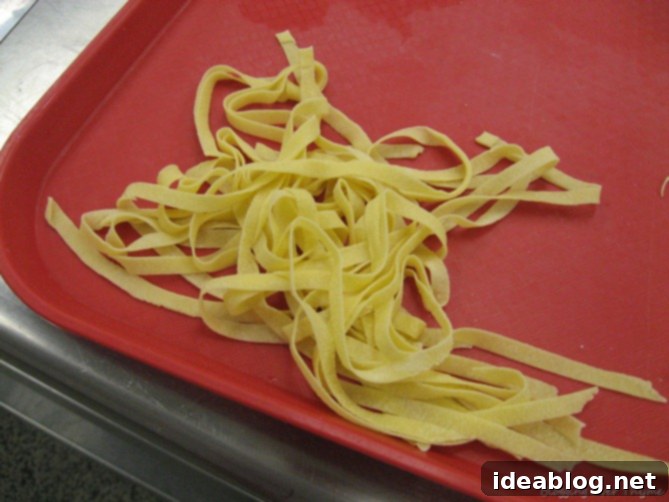
Crafting the Ideal Pasta Dough: A Step-by-Step Guide
Our process began with a precisely measured amount of pasta flour, seasoned with salt, creating a generous well in its center. Into this flour crater, we carefully added a single egg yolk and a minute quantity of olive oil. It’s imperative not to add too much oil, as this can result in a greasy dough that is impossible to roll thinly. Using a whisk, we gently incorporated the egg, gradually drawing in more and more of the surrounding flour until the mixture thickened. Once the dough was no longer overly wet, we switched to a bench scraper, pressing and folding the remaining flour into the mass. The key here is to incorporate, not to knead. Kneading activates too much gluten, making the dough overly elastic and difficult to work with—a texture we wanted to avoid for our delicate pasta.
Chef Brian’s instructions emphasized achieving a dough with a specific consistency: dry enough that if you squeezed a piece, it wouldn’t stick to your hand, yet moist enough to hold its shape without cracking during the crucial rolling phase. After achieving this perfect balance, we allowed the dough to rest for 10-15 minutes. This resting period is vital, as it permits the gluten to relax and allows the flour to fully hydrate, resulting in a more pliable and workable dough. Following its rest, we utilized classic, old-fashioned pasta rollers (specifically, the reliable Impalia brand) to meticulously roll the dough into incredibly thin sheets.
Chef Brian shared an invaluable tip: if the pasta sheets are made perfectly and allowed to dry to the precise degree—not too tacky, but certainly not brittle—they should be capable of being rolled and placed on a tray without any additional cornmeal or flour, and the individual strands would not stick together at all. I confess, this revelation made me realize my home pasta-making technique was far from perfect, as sticking was always a recurring issue for me! Once our sheets achieved the desired dryness, we carefully shaped them into elegant linguine.
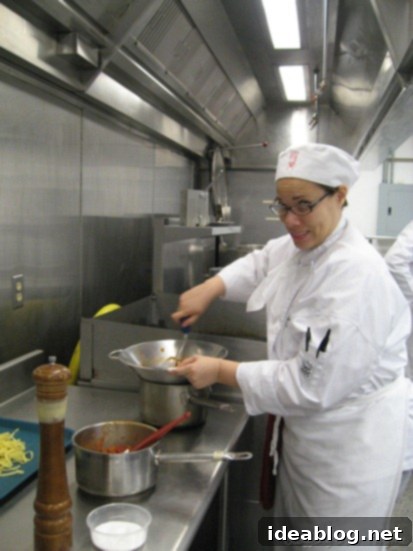
Here, my talented classmate and friend, Tasha, masterfully operates the food mill, a crucial tool for our sauce!
Simple Yet Sensational: Pairing Pasta with Homemade Sauces
To complement our freshly made pasta, we prepared a deceptively simple yet utterly delicious tomato and onion sauce. The process began by sautéing finely chopped onions in rich olive oil until translucent and fragrant. To this aromatic base, we added high-quality canned San Marzano plum tomatoes, renowned for their sweet, balanced flavor. After simmering and cooking for a period, with careful adjustments of tomato paste for thickening and juice for thinning, we passed the entire mixture through a food mill. This traditional tool effectively removes all fibrous parts, seeds, and skins, yielding an incredibly smooth, velvety sauce that truly highlights the pure essence of the tomatoes.
The intentional simplicity of the tomato sauce served a specific purpose: it was designed to be the perfect canvas for a generous addition of homemade basil pesto—another one of my culinary weaknesses! I genuinely believe I could subsist on pesto daily and find immense contentment. Because we intended to blend the pesto into the tomato sauce, we prepared it with a thicker consistency and significantly less oil than usual, incorporating a substantial amount of garlic to ensure a powerful, aromatic punch. The resulting combination was absolutely divine!
I often worry about “tainting” the perfection of pesto by combining it with other ingredients, but this particular pairing shattered all my preconceptions. The creamy, garlicky pesto intertwined seamlessly with the bright tomato sauce, creating a complex flavor profile that was truly unforgettable. I am absolutely certain I will recreate this dish at home. The pasta itself turned out flawlessly, achieving the coveted non-stick perfection Chef Brian described. I happily devoured the entire plate, savoring every single bite.
Mastering the Classic Omelet: The L’Academie Way
In addition to our pasta triumph, this day also marked our inaugural foray into making omelets, specifically in the classic L’Academie style. While we will explore various omelet methods in the future, today’s focus was on crafting a perfectly executed Gruyere cheese-filled omelet. Our instructors emphasized that with proper pan seasoning, even a stainless steel sauté pan can achieve a near non-stick surface. As we’ve learned, heating metal renders it porous, allowing it to absorb fat and, through this process, create a naturally less adhesive cooking surface.
However, for the specific purpose of today’s technical practice, we utilized special chef’s non-stick pans to ensure optimal conditions for refining our technique. While my partner, Blanca, adeptly managed the final stages of the pasta, I was tasked with making omelets to order at my station on a tabletop burner. For preparation, we vigorously whisked approximately 14 eggs (from which we served five omelets) and meticulously strained them. This straining process, which we apply to virtually everything in the kitchen, ensures an incredibly smooth and uniform egg mixture, free of any chalazae or inconsistencies, leading to a perfectly delicate texture.
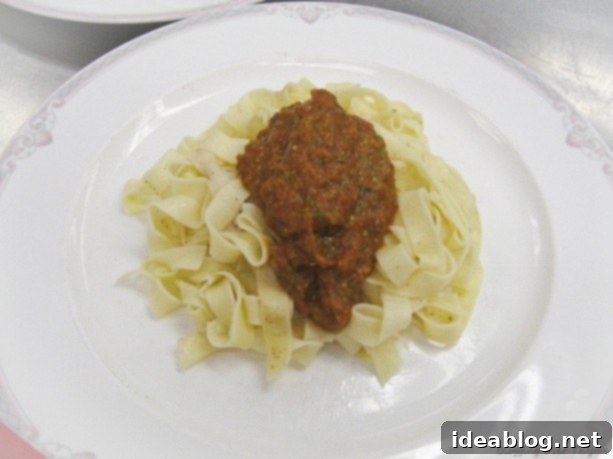
To portion each three-egg omelet (with each egg weighing approximately 2 ounces), we cleverly used a 6-ounce ladle—a precise and efficient method. We then added the measured egg mixture to a tiny non-stick pan, which we had lightly seasoned with clarified butter. The crucial next step involved using a spatula to rapidly agitate and scramble the eggs in the pan, ensuring they cooked evenly but didn’t set too quickly. Once the eggs were partially set but still moist, we spread them evenly across the pan, sprinkled on the delicious Gruyere cheese, and then, using a specialized technique, expertly folded the omelet into a neat, envelope-like shape directly onto the plate.
The hallmark of a perfect classic French omelet is its unblemished golden-yellow color, with absolutely no browning whatsoever. I was incredibly pleased with the outcome of my omelets; they met all the criteria for perfection, showcasing the refined technique we had diligently practiced.
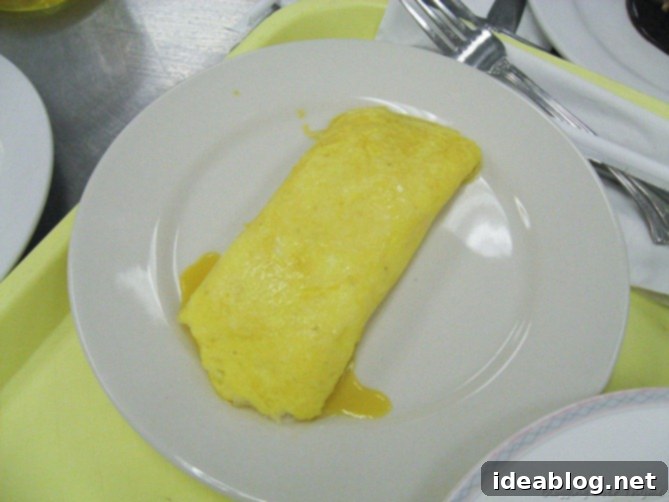
The Exquisite Paris-Brest: A Culinary Delight
To crown our delicious meal, we continued to perfect our pâte à choux technique, but with a delightful twist. Today, we ventured into creating the “LE PARIS BREST.” This classic French dessert features pâte à choux piped into an elegant wreath-like shape, topped generously with raw sliced almonds, and ultimately filled with a rich pastry cream. Unlike the traditional or coffee pastry creams from previous days, we elevated this version by incorporating fragrant hazelnut paste and a small amount of rum, transforming it into a luxurious praline pastry cream.
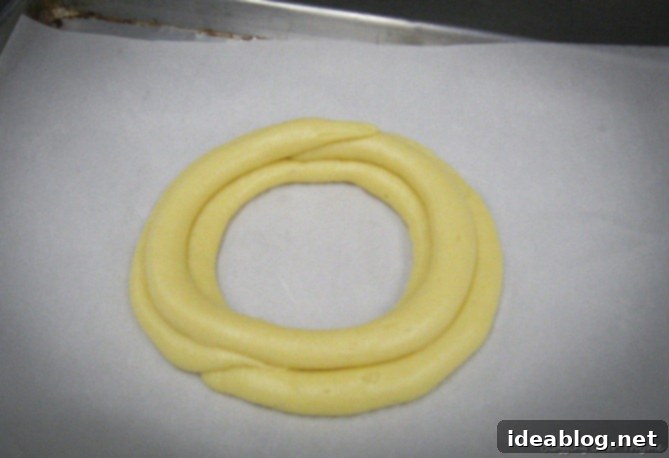
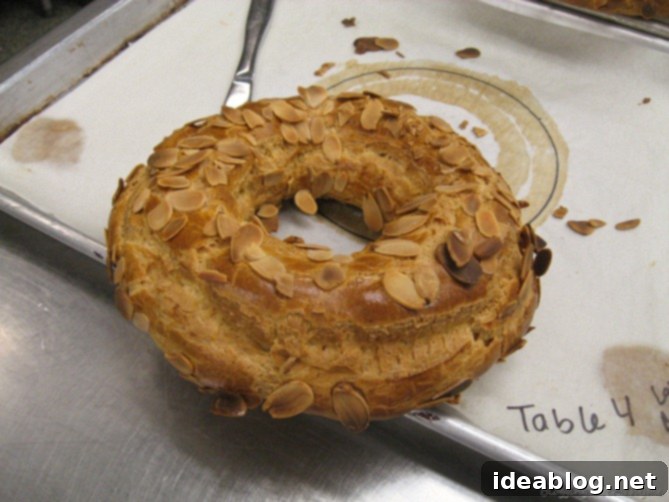
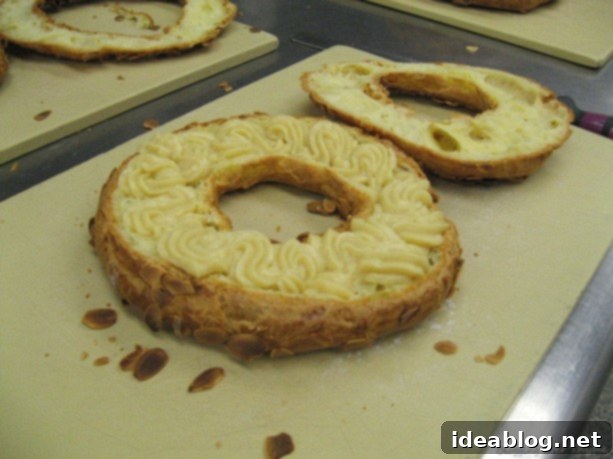
The dessert’s intriguing name, “Paris-Brest,” pays homage to a historic bicycle race between Paris and the town of Brest in France, as its circular, wheel-like shape beautifully mirrors the design of a bicycle wheel. We served this stunning creation in elegant slices, artfully placed atop a luscious homemade chocolate sauce, concocted simply from semi-sweet chocolate, water, and a hint of sugar. The subtle bitterness of the chocolate sauce perfectly complemented the rich, nutty praline cream and light pâte à choux.
Despite having made pâte à choux three times this week, I was utterly surprised to find myself not tired of it in the slightest! My newfound adoration for this dessert was unexpected, as I generally don’t consider myself a “dessert person.” However, the Paris-Brest, especially with that incredible chocolate sauce, was irresistible. The presentation was also incredibly charming and fun to plate, making it an ideal candidate for a special dinner party or a memorable birthday celebration.
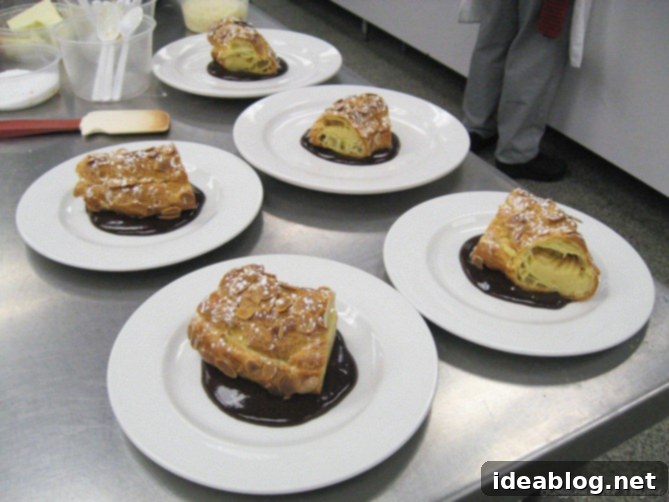
Reflecting on a Productive Day: Theory and Practice
After a thoroughly satisfying lunch and a meticulous clean-up of the kitchen, the afternoon transitioned to classroom activities. We dedicated time to a quick exam review, preparing for upcoming assessments. The latter part of the afternoon was scheduled for presentations on our research papers, which had been postponed due to earlier time constraints. Unfortunately, we only managed to get through three presentations, and mine was not among them, meaning I’ll have to present sometime next week. I’m already finding myself struggling to recall all those fascinating saffron facts!
It was a day that perfectly blended practical skill-building with theoretical knowledge, showcasing the comprehensive nature of our culinary training. I eagerly await tomorrow’s recap, which will cover yesterday’s initial practical and theory exams, marking another significant step in this exciting culinary journey.
